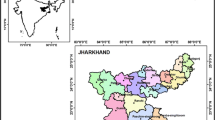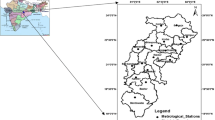Abstract
Under condition of climate changes as global warming, monitoring and detecting trend of precipitation volume is essential and will be useful for agricultural sections. Considering the fact that there were not enough research related to precipitation volume, this study aimed to determine trends in precipitation volume, monthly and annually in different regions of Fars province for the last three decades (33 years period; 1978–2010). Fars province is located in arid and semi-arid regions of Iran, and it plays an important role in agricultural production. Inverse distance weighting interpolation method was used to provide precipitation data for all regions. To analyze the trends of precipitation volume, Mann–Kendall test, Sen’s slope estimator, and 10-year moving average low-pass filter (within time series) were used. The negative trends were identified by the Sen’s slope estimator as well as Mann–Kendall test. However, all the trends were insignificant at the surveyed confidence level (95%). With regards to the application of 10-year moving average low-pass filter, a considerable decreasing trend was observed after around year 1994. Since one of the most important restrictions in agricultural development of the Fars province is lack of sufficient water resources, any changes onward to lack of sufficient precipitation impose impressive pressure and stress on valuable resources and subsequently agricultural production.


















Similar content being viewed by others
References
ArcGIS (2008) ArcGIS Desktop 9.3 Demos. esri.com. 2008-06-26. Retrieved 2009-04-16
Bailey TC, Gatrell AC (1995) Interactive spatial data analysis. Longman, Essex, p 413
Box GEP, Cox DR (1964) An analysis of transformations. J R Stat Soc, Ser B 26(2):211–252
Burrough PA, McDonnell RA (1998) Principles of geographical information systems. Oxford University Press, Oxford, p 333
Crochet P (2007) A study of regional precipitation trends in Iceland using a high-quality gauge network and ERA-40. Am Meteorol Soc 20:4659–4677
Dinpashoh Y, Jhajharia D, Fakheri-Fard A, Singh VP, Kahya E (2011) Trends in reference crop evapotranspiration over Iran. J Hydrol 399:422–433
Dirks KN, Hay JE, Stow CD, Harris D (1998) High-resolution studies of rainfall on Norfolk Island: part II: interpolation of rainfall data. J Hydrol 208(3–4):187–193
Dubois G (1998) Spatial Interpolation Comparison 97: foreword and introduction. J Geogr Inf Decis Anal 2:1–10
Dubois G, Malczewski J, De Cort M (2003) Mapping radioactivity in the environment. Spatial Interpolation Comparison 97. EUR 20667 EN, EC, pp 268
Durbin J, Watson GS (1950) Testing for serial correlation in least squares regression: I. Biometrika 37(3–4):409–428
Durbin J, Watson GS (1951) Testing for serial correlation in least squares regression: II. Biometrika 38(1–2):159–178
Durbin J, Watson GS (1971) Testing for serial correlation in least squares regression: III. Biometrika 58(1):1–19
Fotheringham AS, O’Kelly ME (1989) Spatial interaction models: formulations and applications. Kluwer, Boston, p 224
Ghahraman B, Taghvaeian S (2008) Investigation of annual rainfall trends in Iran. J Agric Sci Technol 10:93–97
Hartkamp AD, De Beurs K, Stein A, White JW (1999) Interpolation techniques for climate variables. NRG-GIS series 99-01. CIMMYT, Mexico
Hofierka J, Parajka J, Mitasova H, Mitas L (2002) Multivariate interpolation of precipitation using regularized spline with tension. Trans GIS 6(2):135–150
IRIMO (2010) Iranian Meteorological Organization. Data Processing Center, Tehran
Jaagus J (2006) Climatic changes in Estonia during the second half of the 20th century in relationship with changes in large-scale atmospheric circulation. Theor Appl Climatol 83:77–88
Jarque CM, Bera AK (1987) A test for normality of observations and regression residuals. Int Stat Rev 55(2):163–172
Jiang T, Su B, Hartmann H (2007) Temporal and spatial trends of precipitation and river flow in the Yangtze River Basin, 1961–2000. Geomorphology 85:143–154
Kebaili Bargaoui Z (2009) Comparison of two kriging interpolation methods applied to spatiotemporal rainfall. J Hydrol 365:56–73
Kiely G (1999) Climate change in Ireland from precipitation and stream flow. Adv Water Res 23:141–151
Kousari MR, Asadi Zarch MA (2011) Minimum, maximum, and mean annual temperatures, relative humidity, and precipitation trends in arid and semi-arid regions of Iran. Arab J Geosci 4(5–6):907–914. doi:10.1007/s12517-009-0113-6
Kousari MR, Ekhtesasi MR, Tazeh M, Sarmi Naeini MA, Asadi Zarch MA (2011) An investigation of the Iranian climatic changes by considering the precipitation, temperature, and relative humidity parameters. Theor Appl Climatol 103:321–325
Landsea CW, Gray WM (1992) The strong association between Western Sahel monsoon rainfall and intense Atlantic hurricanes. J Clim 5(5)
Lloyd CD (2005) Assessing the effect of integrating elevation data into the estimation of monthly precipitation in Great Britain. J Hydrol 308:128–150
Longley PA, Goodchild MF, Maguire DJ, Rhind DW (2001) Geographic information systems and science. Wiley, Chichester, p 454
Lu GY, Wong DW (2008) An adaptive inverse-distance weighting spatial interpolation technique. Comput Geosci 34:1044–1055
Modarres R, da Silva VPR (2007) Rainfall trends in arid and semi-arid regions of Iran. J Arid Environ 70:344–355
Ngongondo CS (2006) An analysis of long-term rainfall variability, trends and groundwater availability in the Mulunguzi river catchment area, Zomba mountain, Southern Malawi. Quat Int 148:45–50
Partal T, Kahya E (2006) Trend analysis in Turkish precipitation data. Hydrol Processes 20:2011–2026
Philip GM, Watson DF (1982) A precise method for determining contoured surfaces. Aust Pet Explor Assoc J 22:205–212
Rodriguez-Puebla C, Encinas AH, Nieto S, Garmendia J (1998) Spatial and temporal patterns of annual precipitation variability over the Iberian Peninsula. Int J Climatol 18:299–316
Rubel F, Brugger K (2009) 3-Hourly quantitative precipitation estimation over central and northern Europe from rain gauge and radar data. Atmos Res 94:544–554
Salas J (1993) Analysis and modeling of hydrologic time series. In: Maidment D (ed) Handbook of hydrology. McGraw-Hill, New York
Salmi T, Määttä A, Anttila P, Ruoho-Airola T, Amnell T (2002) Detecting trends of annual values of atmospheric pollutants by the Mann-Kendall test and Sen’s slope estimates - the Excel template application MAKESENS. Finnish Meteorological Institute, Helsinki
Sen PK (1968). Estimates of the regression coefficient based on Kendall’s Tau. J Am Stat Assoc 63:1379–1389
Soufi M (2004) Morpho-climatic classification of gullies in Fars province, southwest of Iran. In: ISCO 2004—13th International Soil Conservation Organisation Conference, Brisbane
Tabari H, Hosseinzadeh Talaee P (2011) Temporal variability of precipitation over Iran: 1966–2005. J Hydrol 396:313–320
Tabari H, Shifteh Somee B, Rezaeian Zadeh M (2011) Testing for long-term trends in climatic variables in Iran. Atmos Res 100:132–140
Tosic I (2004) Spatial and temporal variability of winter and summer precipitation over Serbia and Montenegro. Theor Appl Climatol 77:47–56
von Storch H, Navarra A (1995) Analysis of climate variability—applications of statistical techniques. Springer, New York
Watson DF, Philip GM (1985) A refinement of inverse distance weighted interpolation. Geoprocessing 2:315–327
Watson FGR, Newman WB (2009) Mapping mean annual precipitation using trivariate kriging. In: Garrott RA, White PJ, Watson FGR (eds) The ecology of large mammals in Central Yellowstone. Elsevier, San Diego
Williams CKI (1998) Prediction with Gaussian processes: from linear regression to linear prediction and beyond. In: Jordan MI (ed) Learning in graphical models. MIT, Cambridge, pp 599–612
Yu Y, Zou S, Whittemore D (1993) Non-parametric trend analysis of water quality data of rivers in Kansas. J Hydrol 150:61–80
Yue S, Hashino M (2003) Temperature trends in Japan: 1900–1996. Theor Appl Climatol 75:15–27
Yue S, Wang C (2004) The Mann–Kendall test modified by effective sample size to detect trend in serially correlated hydrological series. Water Res Manag 18:201–218
Zhang X, Vincent LA, Hogg WD, Niitsoo A (2000) Temperature and precipitation trends in Canada during the 20th century. Atmos Ocean 38:395–429
Acknowledgment
The authors gratefully appreciate the Cadastre group (Management Center for Strategic Projects) in Fars Organization of Agricultural Jahad for their support and providing research facilities.
Author information
Authors and Affiliations
Corresponding author
Rights and permissions
About this article
Cite this article
Ahani, H., Kherad, M., Kousari, M.R. et al. An investigation of trends in precipitation volume for the last three decades in different regions of Fars province, Iran. Theor Appl Climatol 109, 361–382 (2012). https://doi.org/10.1007/s00704-011-0572-z
Received:
Accepted:
Published:
Issue Date:
DOI: https://doi.org/10.1007/s00704-011-0572-z




